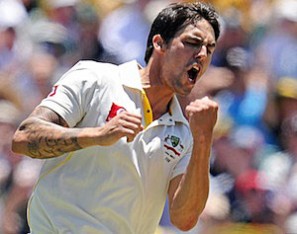WATCH: Freddy Flintoff's son dominates County 2nds game batting exactly like his dad
Check out some of the short-arm pull shots from Rocky Flintoff!

The second Test match between Australia and the West Indies in Port-of-Spain was one for the purists. Unfortunately it wouldn’t have appealed to many others.
Old-fashioned openers who love the graft would have hung off every leave, block and leg glance from the batsmen.
Honest, stump-to-stump bowlers would have rejoiced at the fact that the usually intimidating quicks had to put the short ball away and bowl full and straight.
It was a style of game dictated to the players by the slow, low, turning wicket that had been prepared for them.
Fluid stroke-makers were forced to rein in the expansive drives and put away the cross-bat shots beloved of stadium and television audiences.
Shane Watson, a man who plays all the shots and scores at a good clip, was made to graft for his 56 off 172 deliveries in the first innings.
He had his timber reduced to rubble in the second innings by a ball that darted back and kept a little low. It was that sort of pitch.
When you were in you had to work very hard for your runs. When your luck was out, so were you.
On the first morning, Michael Holding commented that there was “very little living on that pitch”. The pitch looked and played dead.
Despite the odd burst of liveliness from a Kemar Roach or James Pattinson delivery on the second day, there was nothing for the pace batteries to get excited about.
Among the quicks, only Roach plundered wickets, taking 10 for the match. No one else bowling seam up even came close.
Despite the young fast-man’s best efforts, there was little Caribbean flair in this fixture.
While the commentators lamented Curtly Ambrose for not helping bring through the next generation of West Indies quicks, barely a ball rose above the waist the entire match.
Ambrose himself would have struggled to extract pace and bounce from a surface that resembled rolled dust.
The ground was full of singing and cheering Windies fans on Sunday, but during the week it was emptier than a student’s wallet.
Admittedly this was predominantly due to poor scheduling, but the intense, fun atmosphere on day one was about all the game had going for it.
The scoring was drearily slow and the lack of bounce and runs meant that channel flicking grew more tempting with each delivery.
After the fourth day, Ed Cowan commented that the condition of the Trinidad wicket meant that smaller scores felt like they were worth a lot more: “I think in these conditions to ground out 40 or 50 is a bloody good day.”
“To grind out 20 doesn’t look (great) but it still feels like you’ve given some contribution to the team, not just taken the shine off the ball for the other blokes,” Cowan continued.
Scoring runs was not made to look easy across the four days and this was reflected in Australia’s run rate of 2.39 across their two innings. This was despite their line-up being filled with stroke-makers.
Crowds don’t flock to see batsmen nudge their way to 30s.
Contributing to the lull were the many stoppages across all five days.
Bad light, rain and technical difficulties meant that almost a full day was lost in a match that could have yielded all three possible results had forty more overs been played.
A half hour was lost because there was no television feed operational in the ground on the third morning of the Test. In an international-grade cricket stadium one would think this was impossible.
This game truly was one for the purists. Unfortunately, the games the purists love can be the ones that others find boring. For long patches this was one of those.
West Indies cricket can’t afford to host boring Test matches.
It is a region that many people fear is losing its grip on the crowds in the Test-match arena.
In the shorter formats the team has enjoyed decent success, recently drawing both the one-day and Twenty20 series against Australia.
The comparative lack of success in the Test arena has meant that the West Indies has gravitated towards the limited-overs formats.
Unlike many other nations, Test cricket has started to lose its grip over West Indian cricketers as well.
There are at least four players would make the starting Test 11 who preferred to play in the IPL than against Australia.
Despite missing Dwayne Bravo, Sunil Narine, Marlon Samuels and Chris Gayle, the young Windies outfit are still providing stiff resistance to an Aussie team that is struggling to acclimatise to the conditions.
You can’t blame the big guns for chasing the money. The West Indies players taking the field in this Test series are playing for a relative pittance on decks that wouldn’t draw crowds anywhere in the world.
It has been reported that West Indies central contracts are worth less than US $100,000 annually. Meanwhile, Sunil Narine is earning $700,000 for six weeks of cricket in the IPL.
If the West Indies Cricket Board wants to promote Test cricket as the game’s premier format then a lot must be done to rectify the current problems.
The first step has to be ensuring that the Test cricket that is played in the region is entertaining.
Preparing low, slow wickets that don’t give batsmen opportunities to showcase their shots and don’t give fast bowlers enough pace and bounce to find edges is not acceptable.
If it continues then those who foretold the death of Test cricket may be writing about its first victim in the coming years.